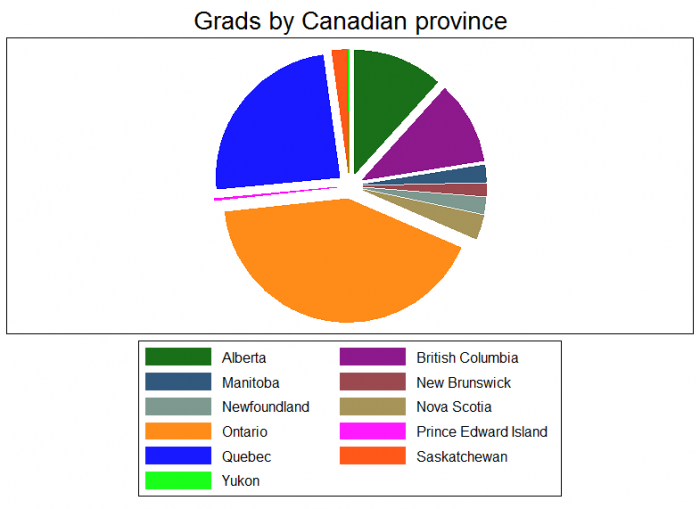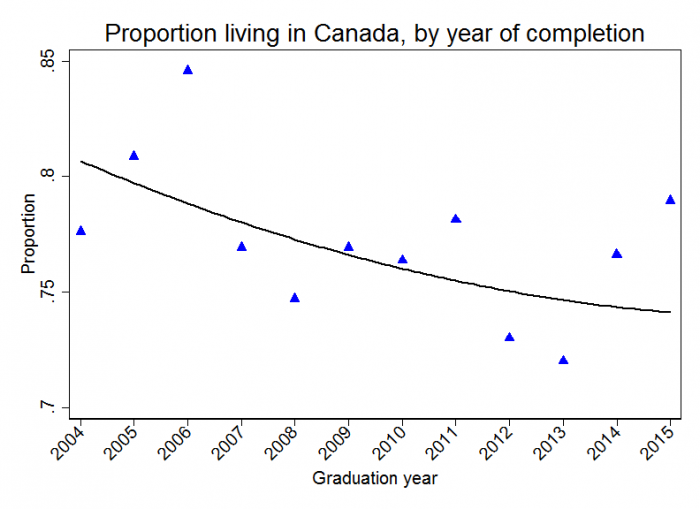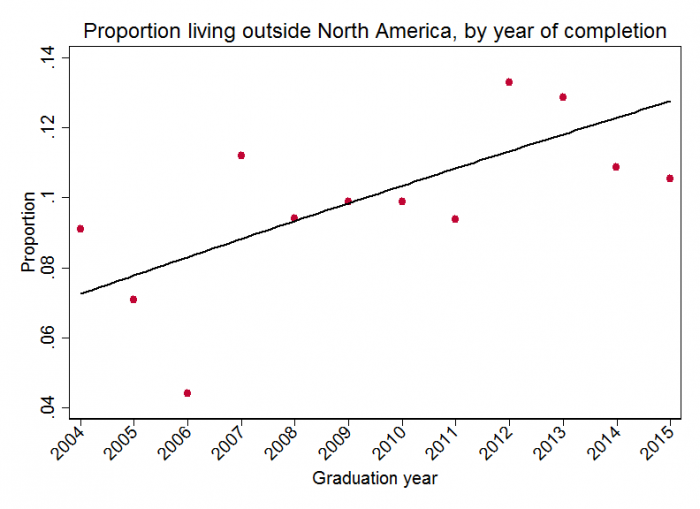We previously noted that most of the grads in our sample currently reside in North America. Does time on the job market play a role in determining grads’ place of residence? Are recent grads more likely to seek and/or accept positions outside Canada or North America? Are grads particularly concentrated within certain Canadian provinces? In this post, we look at the association between year of graduation and place of residence, as well as within-Canada residential patterns.
Looking specifically at our Canadian residents (77% of our current sample), we find that the provincial distribution of grads aligns relatively well with that of the general Canadian population, with most grads residing in Ontario, Quebec, Alberta, and British Columbia. We also find that the proportion of grads residing in the same province as their PhD institution increases steadily by graduation year. This makes sense, as recent grads who remain in Canada may be more inclined to search for jobs nearby and/or secure postdoc or contract positions at their degree-granting institutions.

Zooming out to our overall sample, we can assess whether the likelihood of living in Canada (versus anywhere else in the world) is associated with year of completion. Statistically, we find a weak relationship between year of graduation and the odds of residing in Canada in this sample. The plot below demonstrates this negative association (on average, the odds of living in Canada decrease slightly in more recent graduation years), but it also suggests that this relationship is relatively erratic and potentially non-linear. Similarly, we find a slight increase in the proportion of grads living abroad (outside North America) in more recent graduation years, potentially reflecting greater early-career flexibility, shifting geographical preferences, or perhaps even an increasing number of international PhD students (although we can’t demonstrate any of these relationships with our current dataset).


Next time, we’ll take a closer look at the specific occupation types within our overarching employment categories, beginning with an assessment of trends in tenure-track employment by gender.
We previously noted that most of the grads in our sample currently reside in North America. Does time on the job market play a role in determining grads’ place of residence? Are recent grads more likely to seek and/or accept positions outside Canada or North America? Are grads particularly concentrated within certain Canadian provinces? In this post, we look at the association between year of graduation and place of residence, as well as within-Canada residential patterns.
Looking specifically at our Canadian residents (77% of our current sample), we find that the provincial distribution of grads aligns relatively well with that of the general Canadian population, with most grads residing in Ontario, Quebec, Alberta, and British Columbia. We also find that the proportion of grads residing in the same province as their PhD institution increases steadily by graduation year. This makes sense, as recent grads who remain in Canada may be more inclined to search for jobs nearby and/or secure postdoc or contract positions at their degree-granting institutions.

Zooming out to our overall sample, we can assess whether the likelihood of living in Canada (versus anywhere else in the world) is associated with year of completion. Statistically, we find a weak relationship between year of graduation and the odds of residing in Canada in this sample. The plot below demonstrates this negative association (on average, the odds of living in Canada decrease slightly in more recent graduation years), but it also suggests that this relationship is relatively erratic and potentially non-linear. Similarly, we find a slight increase in the proportion of grads living abroad (outside North America) in more recent graduation years, potentially reflecting greater early-career flexibility, shifting geographical preferences, or perhaps even an increasing number of international PhD students (although we can’t demonstrate any of these relationships with our current dataset).


Next time, we’ll take a closer look at the specific occupation types within our overarching employment categories, beginning with an assessment of trends in tenure-track employment by gender.
Discussion